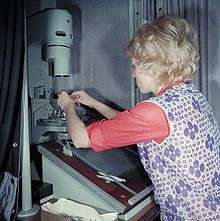Quality control

Quality control, or QC for short, is a process by which entities review the quality of all factors involved in production. ISO 9000 defines quality control as "A part of quality management focused on fulfilling quality requirements".[1]
This approach places an emphasis on three aspects:
- Elements such as controls, job management, defined and well managed processes,[2][3] performance and integrity criteria, and identification of records
- Competence, such as knowledge, skills, experience, and qualifications
- Soft elements, such as personnel, integrity, confidence, organizational culture, motivation, team spirit, and quality relationships.
Controls include product inspection, where every product is examined visually, and often using a stereo microscope for fine detail before the product is sold into the external market. Inspectors will be provided with lists and descriptions of unacceptable product defects such as cracks or surface blemishes for example.
The quality of the outputs is at risk if any of these three aspects is deficient in any way.
Quality control emphasizes testing of products to uncover defects and reporting to management who make the decision to allow or deny product release, whereas quality assurance attempts to improve and stabilize production (and associated processes) to avoid, or at least minimize, issues which led to the defect(s) in the first place. For contract work, particularly work awarded by government agencies, quality control issues are among the top reasons for not renewing a contract.[4]
Notable approaches
There is a tendency for individual consultants and organizations to name their own unique approaches to quality control—a few of these have ended up in widespread use:
| Terminology | Approximate year of first use | Description |
|---|---|---|
| Statistical quality control (SQC) | 1930s | The application of statistical methods (specifically control charts and acceptance sampling) to quality control.[5]:556 |
| Total quality control (TQC) | 1956 | Popularized by Armand V. Feigenbaum in a Harvard Business Review article[6] and book of the same name.[7] Stresses involvement of departments in addition to production (e.g., accounting, design, finance, human resources, marketing, purchasing, sales). |
| Statistical process control (SPC) | 1960s | The use of control charts to monitor an individual industrial process and feed back performance to the operators responsible for that process. Inspired by control systems. |
| Company-wide quality control (CWQC) | 1968 | Japanese-style total quality control[7] |
| Total Quality Management (TQM) | 1985 | Quality movement originating in the United States Department of Defense that uses (in part) the techniques of statistical quality control to drive continuous organizational improvement.[8] |
| Six Sigma (6σ) | 1986 | Statistical quality control applied to business strategy.[9] Originated by Motorola. |
In project management
In project management, quality control requires the project manager and/or the project team to inspect the accomplished work to ensure its alignment with the project scope.[10] In practice, projects typically have a dedicated quality control team which focuses on this area.
See also
- Analytical quality control
- Corrective and preventative action (CAPA)
- Eight dimensions of quality
- First article inspection (FAI)
- Good Automated Manufacturing Practice (GAMP)
- Good manufacturing practice
- Quality assurance
- Quality management framework
- Standard operating procedure (SOP)
References
 This article incorporates public domain material from the General Services Administration document "Federal Standard 1037C" (in support of MIL-STD-188).
This article incorporates public domain material from the General Services Administration document "Federal Standard 1037C" (in support of MIL-STD-188).
- ↑ ISO 9000:2005, Clause 3.2.10
- ↑ Dennis Adsit (November 9, 2007). "What the Call Center Industry Can Learn from Manufacturing: Part I" (PDF). National Association of Call Centers. Retrieved 21 December 2012.
- ↑ Dennis Adsit (November 23, 2007). "What the Call Center Industry Can Learn from Manufacturing: Part II" (PDF). National Association of Call Centers. Retrieved 21 December 2012.
- ↑ "Position Classification Standard for Quality Assurance Series, GS-1910" (PDF). US Office of Personnel Management. March 1983. Retrieved 21 December 2012.
- ↑ Juran, Joseph M., ed. (1995), A History of Managing for Quality: The Evolution, Trends, and Future Directions of Managing for Quality, Milwaukee, Wisconsin: The American Society for Quality Control, ISBN 9780873893411, OCLC 32394752
- ↑ Feigenbaum, Armand V. (1956). "Total Quality Control". Harvard Business Review. Cambridge, Massachusetts: Harvard University Press. 34 (6): 93–101. ISSN 0017-8012. OCLC 1751795.
- 1 2 Ishikawa, Kaoru (1985), What Is Total Quality Control? The Japanese Way (1 ed.), Englewood Cliffs, New Jersey: Prentice-Hall, pp. 90–91, ISBN 978-0-13-952433-2, OCLC 11467749
- ↑ Evans, James R.; Lindsay, William M. (1999), The Management and Control of Quality (4 ed.), Cincinnati, Ohio: South-Western College Publications, p. 118, ISBN 9780538882422, OCLC 38475486,
The term total quality management, or TQM, has been commonly used to denote the system of managing for total quality. (The term TQM was actually developed within the Department of Defense. It has since been renamed Total Quality Leadership, since leadership outranks management in military thought.)
- ↑ "What Is Six Sigma?" (PDF). http://www.motorolasolutions.com. Schaumburg, Illinois: Motorola University. 2010-02-19. p. 2. Retrieved 2013-11-24.
When practiced as a management system, Six Sigma is a high performance system for executing business strategy.
External link in|website=(help) - ↑ Phillips, Joseph (November 2008). "Quality Control in Project Management". The Project Management Hut. Retrieved 21 December 2012.
Further reading
- Radford, George S. (1922), The Control of Quality in Manufacturing, New York: Ronald Press Co., OCLC 1701274, retrieved 2013-11-16
- Shewhart, Walter A. (1931), Economic Control of Quality of Manufactured Product, New York: D. Van Nostrand Co., Inc., OCLC 1045408
- Juran, Joseph M. (1951), Quality-Control Handbook, New York: McGraw-Hill, OCLC 1220529
- Western Electric Company (1956), Statistical Quality Control Handbook (1 ed.), Indianapolis, Indiana: Western Electric Co., OCLC 33858387
- Feigenbaum, Armand V. (1961), Total Quality Control, New York: McGraw-Hill, OCLC 567344